Innovation and Sustainable Business Practices: Sony Corporation Report
VerifiedAdded on 2023/01/23
|14
|3457
|53
Report
AI Summary
This report provides a comprehensive analysis of Sony Corporation's approach to sustainability and innovation. Part A examines the challenges of implementing sustainable and circular economy practices in consumer society. Part B focuses on Sony's environmental sustainability initiatives, corporate governance, employee development, environmental innovation, and systematic improvement. The report delves into Sony's strategies for making profit from sustainability, stakeholder engagement, and sustainability benchmarks, offering insights into the company's environmental performance and business practices. The analysis highlights key aspects such as energy consumption, carbon dioxide emissions, and waste management, demonstrating Sony's commitment to environmental responsibility. The report also discusses corporate governance, employee development, environmental innovation, and systematic improvement as key strategies for achieving sustainability. Furthermore, it examines stakeholder interests and provides a benchmark of Sony's sustainability performance, including an analysis of complaints received. This report showcases how Sony integrates sustainability into its business model to ensure long-term success.
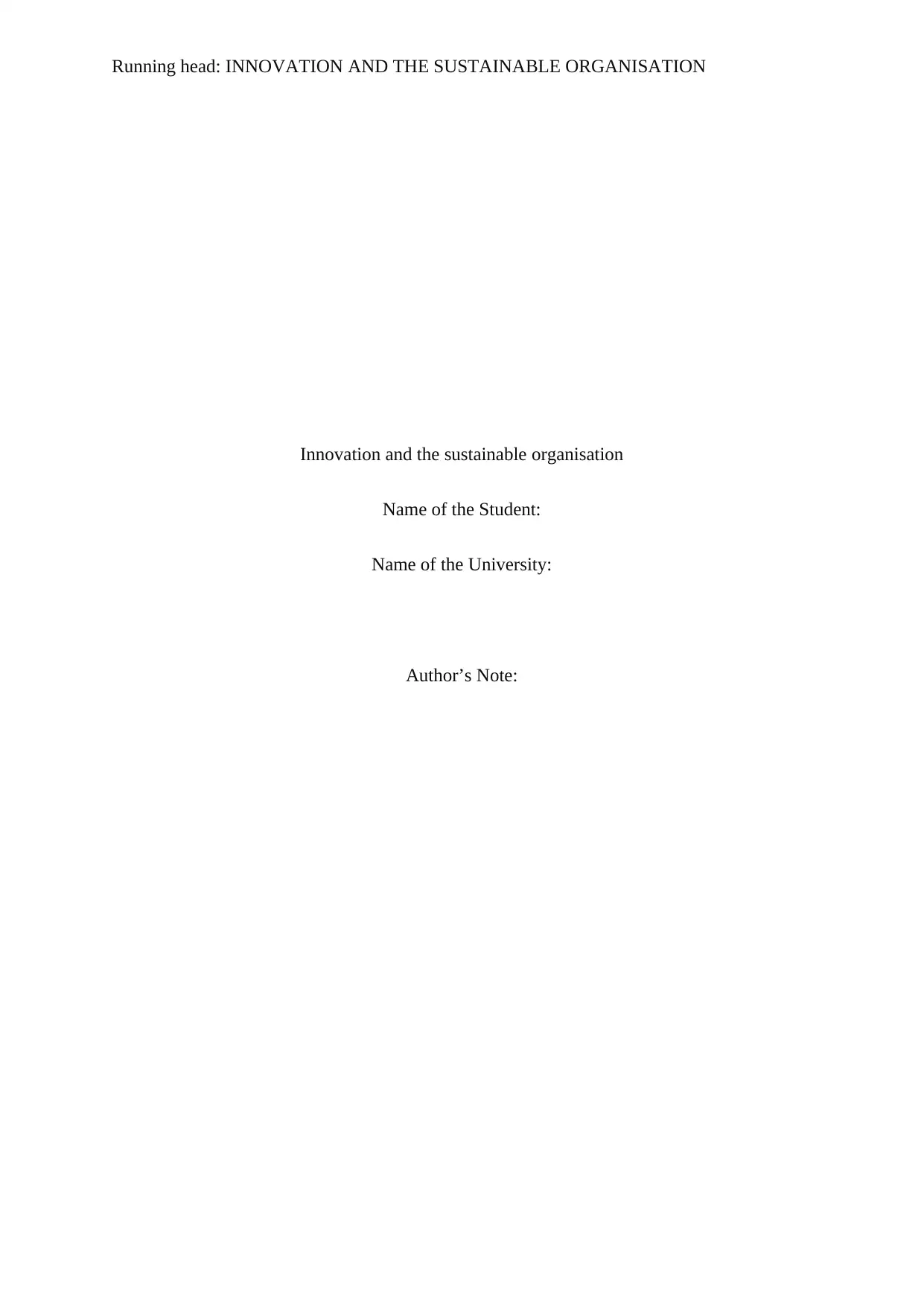
Running head: INNOVATION AND THE SUSTAINABLE ORGANISATION
Innovation and the sustainable organisation
Name of the Student:
Name of the University:
Author’s Note:
Innovation and the sustainable organisation
Name of the Student:
Name of the University:
Author’s Note:
Paraphrase This Document
Need a fresh take? Get an instant paraphrase of this document with our AI Paraphraser

1
INNOVATION AND THE SUSTAINABLE ORGANISATION
Table of Contents
Part A. Sustainability and circular economy analysis................................................................2
Part B:.........................................................................................................................................4
Section 2: Environmental Sustainability analysis..................................................................4
Section 3: sustainability strategy to pursue the sustainability................................................5
Section 4.: Stakeholders’ interest...........................................................................................7
Section 5: Sustainability benchmark......................................................................................8
Conclusion................................................................................................................................10
References................................................................................................................................11
INNOVATION AND THE SUSTAINABLE ORGANISATION
Table of Contents
Part A. Sustainability and circular economy analysis................................................................2
Part B:.........................................................................................................................................4
Section 2: Environmental Sustainability analysis..................................................................4
Section 3: sustainability strategy to pursue the sustainability................................................5
Section 4.: Stakeholders’ interest...........................................................................................7
Section 5: Sustainability benchmark......................................................................................8
Conclusion................................................................................................................................10
References................................................................................................................................11
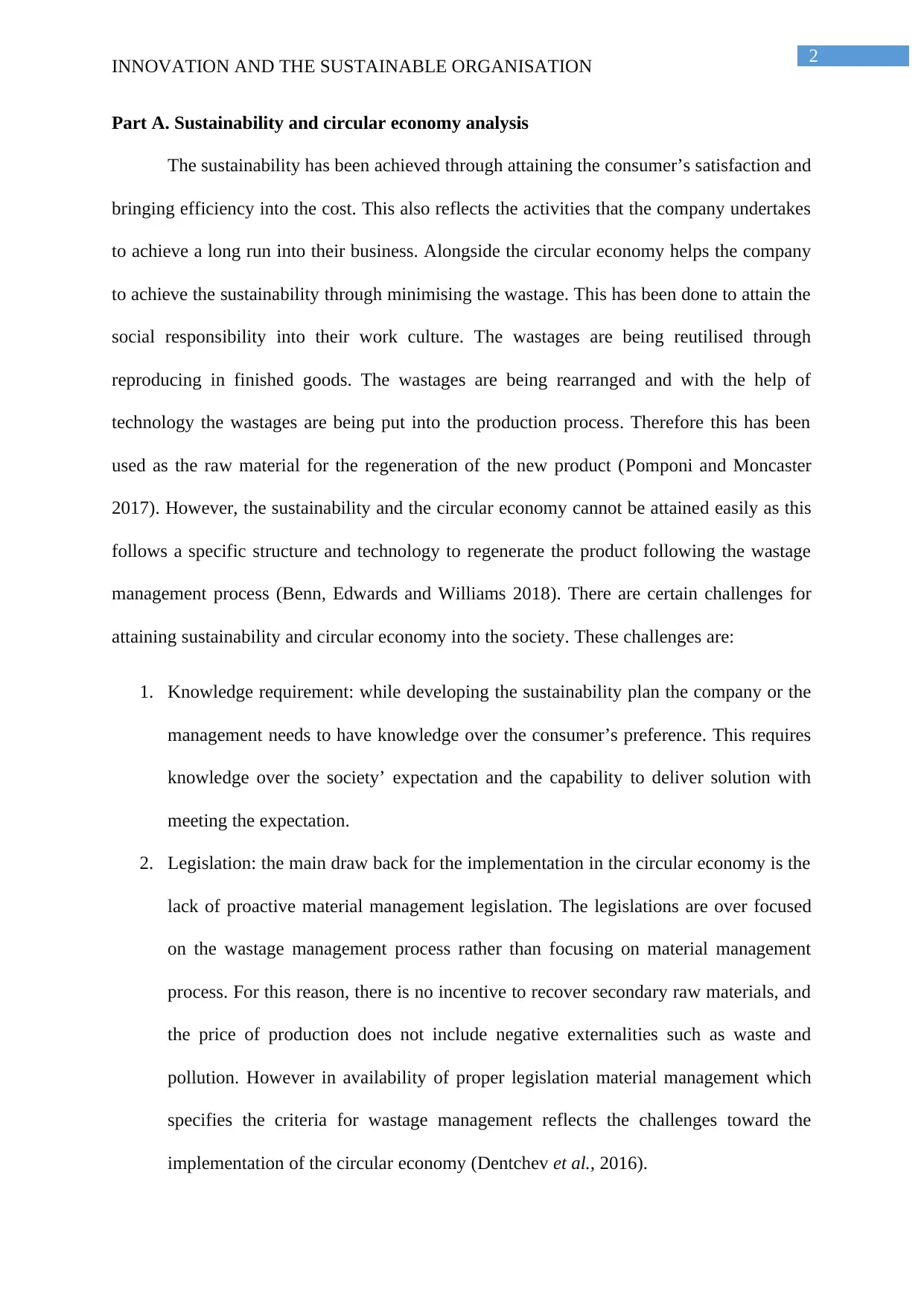
2
INNOVATION AND THE SUSTAINABLE ORGANISATION
Part A. Sustainability and circular economy analysis
The sustainability has been achieved through attaining the consumer’s satisfaction and
bringing efficiency into the cost. This also reflects the activities that the company undertakes
to achieve a long run into their business. Alongside the circular economy helps the company
to achieve the sustainability through minimising the wastage. This has been done to attain the
social responsibility into their work culture. The wastages are being reutilised through
reproducing in finished goods. The wastages are being rearranged and with the help of
technology the wastages are being put into the production process. Therefore this has been
used as the raw material for the regeneration of the new product (Pomponi and Moncaster
2017). However, the sustainability and the circular economy cannot be attained easily as this
follows a specific structure and technology to regenerate the product following the wastage
management process (Benn, Edwards and Williams 2018). There are certain challenges for
attaining sustainability and circular economy into the society. These challenges are:
1. Knowledge requirement: while developing the sustainability plan the company or the
management needs to have knowledge over the consumer’s preference. This requires
knowledge over the society’ expectation and the capability to deliver solution with
meeting the expectation.
2. Legislation: the main draw back for the implementation in the circular economy is the
lack of proactive material management legislation. The legislations are over focused
on the wastage management process rather than focusing on material management
process. For this reason, there is no incentive to recover secondary raw materials, and
the price of production does not include negative externalities such as waste and
pollution. However in availability of proper legislation material management which
specifies the criteria for wastage management reflects the challenges toward the
implementation of the circular economy (Dentchev et al., 2016).
INNOVATION AND THE SUSTAINABLE ORGANISATION
Part A. Sustainability and circular economy analysis
The sustainability has been achieved through attaining the consumer’s satisfaction and
bringing efficiency into the cost. This also reflects the activities that the company undertakes
to achieve a long run into their business. Alongside the circular economy helps the company
to achieve the sustainability through minimising the wastage. This has been done to attain the
social responsibility into their work culture. The wastages are being reutilised through
reproducing in finished goods. The wastages are being rearranged and with the help of
technology the wastages are being put into the production process. Therefore this has been
used as the raw material for the regeneration of the new product (Pomponi and Moncaster
2017). However, the sustainability and the circular economy cannot be attained easily as this
follows a specific structure and technology to regenerate the product following the wastage
management process (Benn, Edwards and Williams 2018). There are certain challenges for
attaining sustainability and circular economy into the society. These challenges are:
1. Knowledge requirement: while developing the sustainability plan the company or the
management needs to have knowledge over the consumer’s preference. This requires
knowledge over the society’ expectation and the capability to deliver solution with
meeting the expectation.
2. Legislation: the main draw back for the implementation in the circular economy is the
lack of proactive material management legislation. The legislations are over focused
on the wastage management process rather than focusing on material management
process. For this reason, there is no incentive to recover secondary raw materials, and
the price of production does not include negative externalities such as waste and
pollution. However in availability of proper legislation material management which
specifies the criteria for wastage management reflects the challenges toward the
implementation of the circular economy (Dentchev et al., 2016).
⊘ This is a preview!⊘
Do you want full access?
Subscribe today to unlock all pages.

Trusted by 1+ million students worldwide
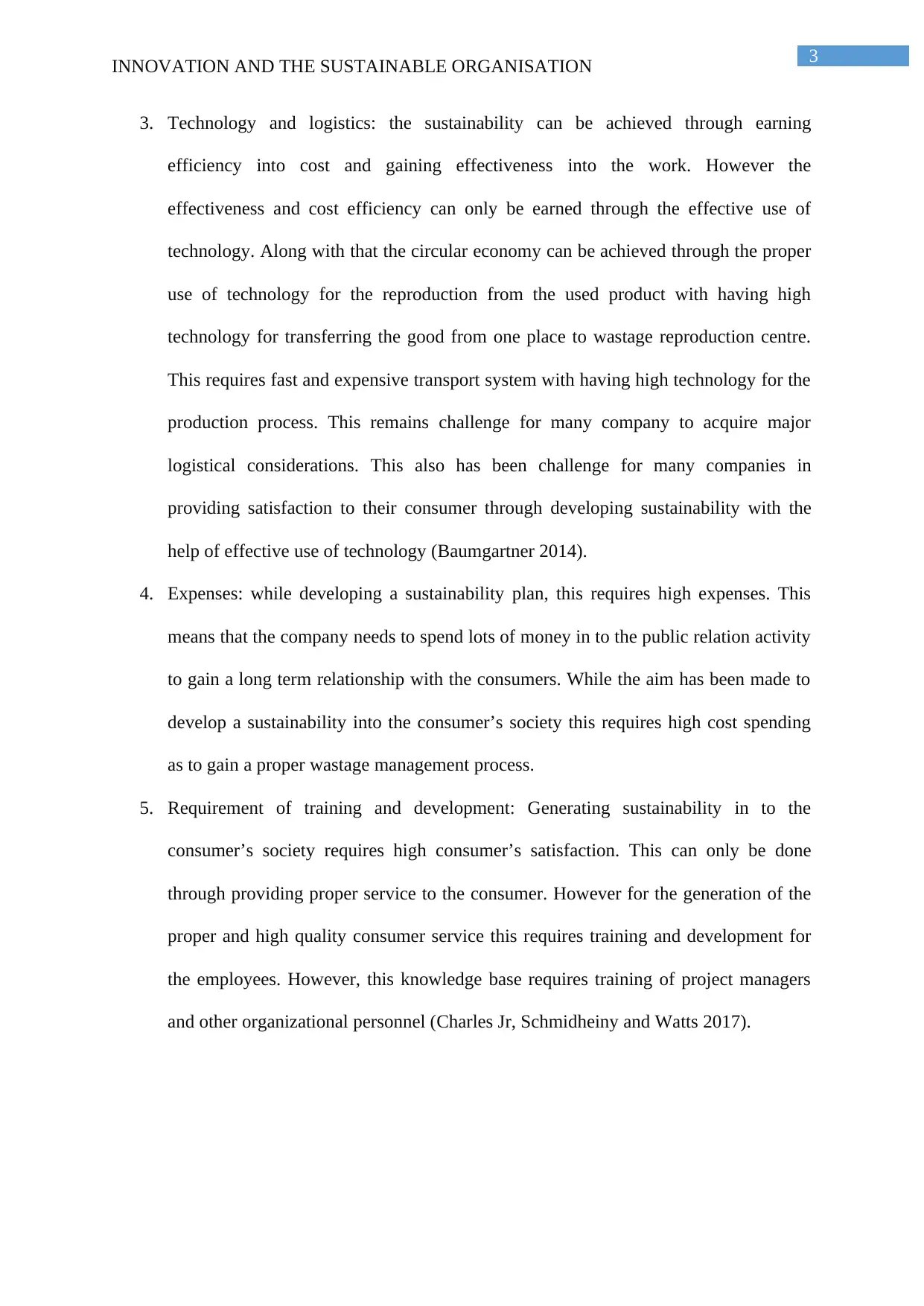
3
INNOVATION AND THE SUSTAINABLE ORGANISATION
3. Technology and logistics: the sustainability can be achieved through earning
efficiency into cost and gaining effectiveness into the work. However the
effectiveness and cost efficiency can only be earned through the effective use of
technology. Along with that the circular economy can be achieved through the proper
use of technology for the reproduction from the used product with having high
technology for transferring the good from one place to wastage reproduction centre.
This requires fast and expensive transport system with having high technology for the
production process. This remains challenge for many company to acquire major
logistical considerations. This also has been challenge for many companies in
providing satisfaction to their consumer through developing sustainability with the
help of effective use of technology (Baumgartner 2014).
4. Expenses: while developing a sustainability plan, this requires high expenses. This
means that the company needs to spend lots of money in to the public relation activity
to gain a long term relationship with the consumers. While the aim has been made to
develop a sustainability into the consumer’s society this requires high cost spending
as to gain a proper wastage management process.
5. Requirement of training and development: Generating sustainability in to the
consumer’s society requires high consumer’s satisfaction. This can only be done
through providing proper service to the consumer. However for the generation of the
proper and high quality consumer service this requires training and development for
the employees. However, this knowledge base requires training of project managers
and other organizational personnel (Charles Jr, Schmidheiny and Watts 2017).
INNOVATION AND THE SUSTAINABLE ORGANISATION
3. Technology and logistics: the sustainability can be achieved through earning
efficiency into cost and gaining effectiveness into the work. However the
effectiveness and cost efficiency can only be earned through the effective use of
technology. Along with that the circular economy can be achieved through the proper
use of technology for the reproduction from the used product with having high
technology for transferring the good from one place to wastage reproduction centre.
This requires fast and expensive transport system with having high technology for the
production process. This remains challenge for many company to acquire major
logistical considerations. This also has been challenge for many companies in
providing satisfaction to their consumer through developing sustainability with the
help of effective use of technology (Baumgartner 2014).
4. Expenses: while developing a sustainability plan, this requires high expenses. This
means that the company needs to spend lots of money in to the public relation activity
to gain a long term relationship with the consumers. While the aim has been made to
develop a sustainability into the consumer’s society this requires high cost spending
as to gain a proper wastage management process.
5. Requirement of training and development: Generating sustainability in to the
consumer’s society requires high consumer’s satisfaction. This can only be done
through providing proper service to the consumer. However for the generation of the
proper and high quality consumer service this requires training and development for
the employees. However, this knowledge base requires training of project managers
and other organizational personnel (Charles Jr, Schmidheiny and Watts 2017).
Paraphrase This Document
Need a fresh take? Get an instant paraphrase of this document with our AI Paraphraser
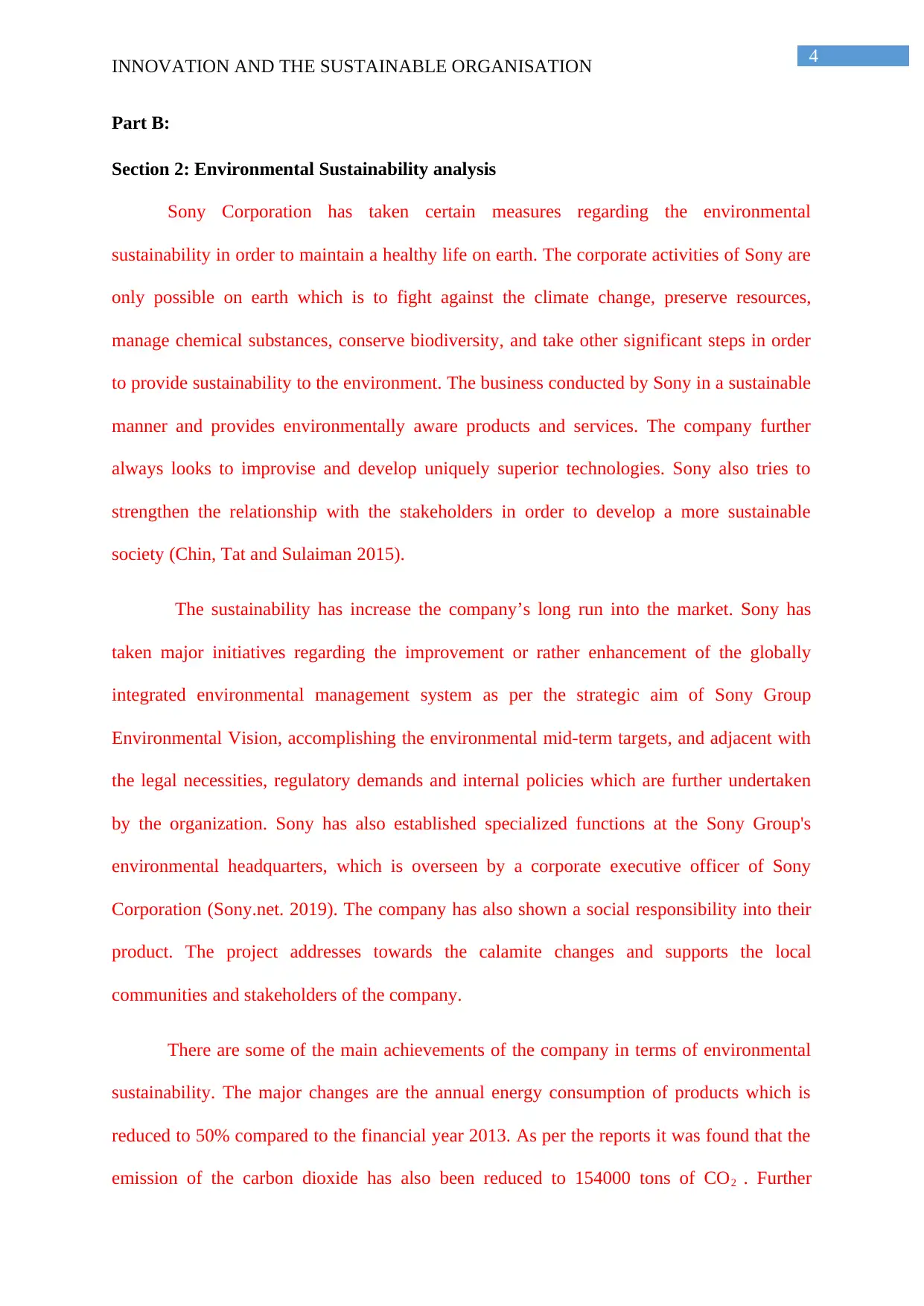
4
INNOVATION AND THE SUSTAINABLE ORGANISATION
Part B:
Section 2: Environmental Sustainability analysis
Sony Corporation has taken certain measures regarding the environmental
sustainability in order to maintain a healthy life on earth. The corporate activities of Sony are
only possible on earth which is to fight against the climate change, preserve resources,
manage chemical substances, conserve biodiversity, and take other significant steps in order
to provide sustainability to the environment. The business conducted by Sony in a sustainable
manner and provides environmentally aware products and services. The company further
always looks to improvise and develop uniquely superior technologies. Sony also tries to
strengthen the relationship with the stakeholders in order to develop a more sustainable
society (Chin, Tat and Sulaiman 2015).
The sustainability has increase the company’s long run into the market. Sony has
taken major initiatives regarding the improvement or rather enhancement of the globally
integrated environmental management system as per the strategic aim of Sony Group
Environmental Vision, accomplishing the environmental mid-term targets, and adjacent with
the legal necessities, regulatory demands and internal policies which are further undertaken
by the organization. Sony has also established specialized functions at the Sony Group's
environmental headquarters, which is overseen by a corporate executive officer of Sony
Corporation (Sony.net. 2019). The company has also shown a social responsibility into their
product. The project addresses towards the calamite changes and supports the local
communities and stakeholders of the company.
There are some of the main achievements of the company in terms of environmental
sustainability. The major changes are the annual energy consumption of products which is
reduced to 50% compared to the financial year 2013. As per the reports it was found that the
emission of the carbon dioxide has also been reduced to 154000 tons of CO2 . Further
INNOVATION AND THE SUSTAINABLE ORGANISATION
Part B:
Section 2: Environmental Sustainability analysis
Sony Corporation has taken certain measures regarding the environmental
sustainability in order to maintain a healthy life on earth. The corporate activities of Sony are
only possible on earth which is to fight against the climate change, preserve resources,
manage chemical substances, conserve biodiversity, and take other significant steps in order
to provide sustainability to the environment. The business conducted by Sony in a sustainable
manner and provides environmentally aware products and services. The company further
always looks to improvise and develop uniquely superior technologies. Sony also tries to
strengthen the relationship with the stakeholders in order to develop a more sustainable
society (Chin, Tat and Sulaiman 2015).
The sustainability has increase the company’s long run into the market. Sony has
taken major initiatives regarding the improvement or rather enhancement of the globally
integrated environmental management system as per the strategic aim of Sony Group
Environmental Vision, accomplishing the environmental mid-term targets, and adjacent with
the legal necessities, regulatory demands and internal policies which are further undertaken
by the organization. Sony has also established specialized functions at the Sony Group's
environmental headquarters, which is overseen by a corporate executive officer of Sony
Corporation (Sony.net. 2019). The company has also shown a social responsibility into their
product. The project addresses towards the calamite changes and supports the local
communities and stakeholders of the company.
There are some of the main achievements of the company in terms of environmental
sustainability. The major changes are the annual energy consumption of products which is
reduced to 50% compared to the financial year 2013. As per the reports it was found that the
emission of the carbon dioxide has also been reduced to 154000 tons of CO2 . Further
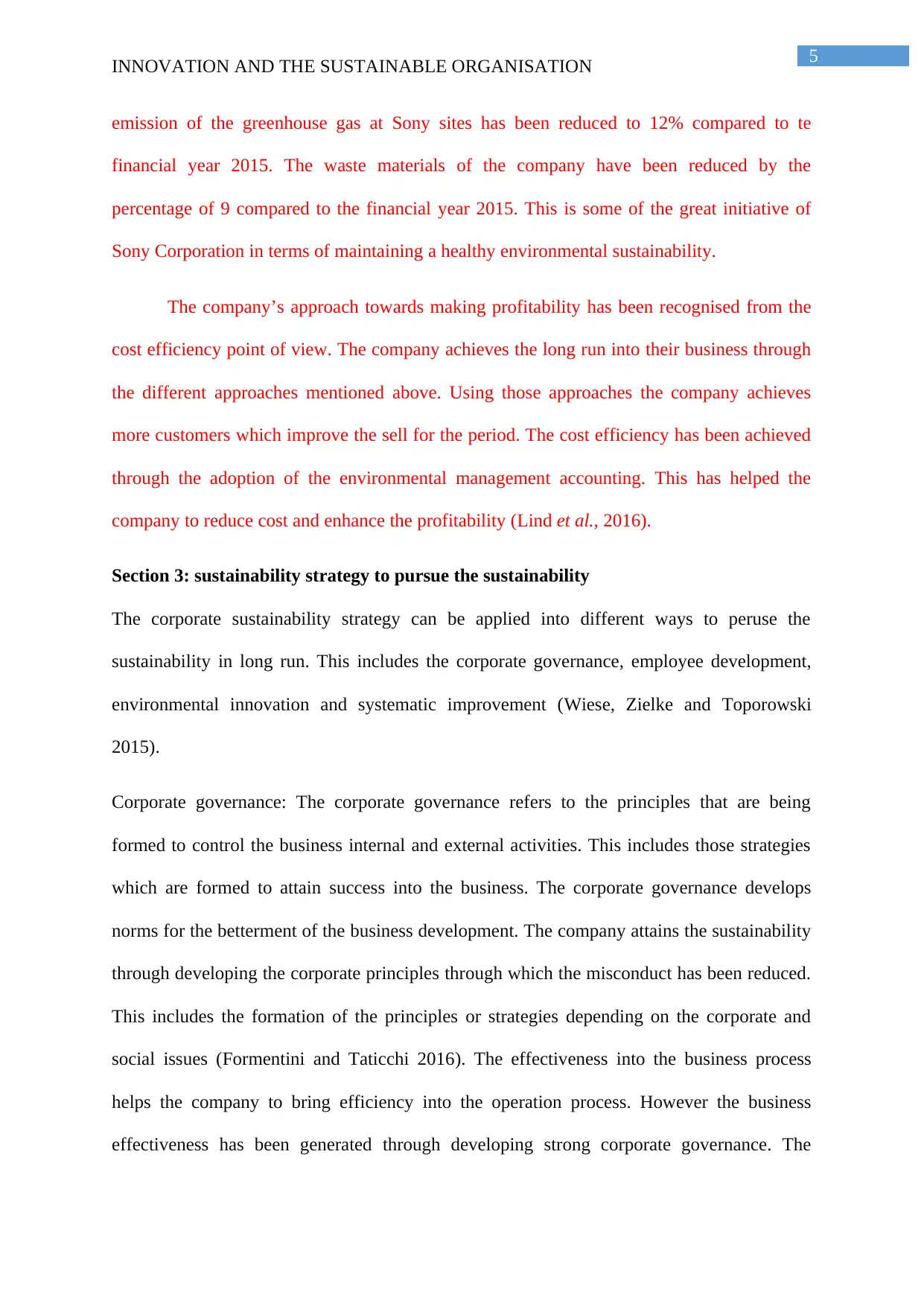
5
INNOVATION AND THE SUSTAINABLE ORGANISATION
emission of the greenhouse gas at Sony sites has been reduced to 12% compared to te
financial year 2015. The waste materials of the company have been reduced by the
percentage of 9 compared to the financial year 2015. This is some of the great initiative of
Sony Corporation in terms of maintaining a healthy environmental sustainability.
The company’s approach towards making profitability has been recognised from the
cost efficiency point of view. The company achieves the long run into their business through
the different approaches mentioned above. Using those approaches the company achieves
more customers which improve the sell for the period. The cost efficiency has been achieved
through the adoption of the environmental management accounting. This has helped the
company to reduce cost and enhance the profitability (Lind et al., 2016).
Section 3: sustainability strategy to pursue the sustainability
The corporate sustainability strategy can be applied into different ways to peruse the
sustainability in long run. This includes the corporate governance, employee development,
environmental innovation and systematic improvement (Wiese, Zielke and Toporowski
2015).
Corporate governance: The corporate governance refers to the principles that are being
formed to control the business internal and external activities. This includes those strategies
which are formed to attain success into the business. The corporate governance develops
norms for the betterment of the business development. The company attains the sustainability
through developing the corporate principles through which the misconduct has been reduced.
This includes the formation of the principles or strategies depending on the corporate and
social issues (Formentini and Taticchi 2016). The effectiveness into the business process
helps the company to bring efficiency into the operation process. However the business
effectiveness has been generated through developing strong corporate governance. The
INNOVATION AND THE SUSTAINABLE ORGANISATION
emission of the greenhouse gas at Sony sites has been reduced to 12% compared to te
financial year 2015. The waste materials of the company have been reduced by the
percentage of 9 compared to the financial year 2015. This is some of the great initiative of
Sony Corporation in terms of maintaining a healthy environmental sustainability.
The company’s approach towards making profitability has been recognised from the
cost efficiency point of view. The company achieves the long run into their business through
the different approaches mentioned above. Using those approaches the company achieves
more customers which improve the sell for the period. The cost efficiency has been achieved
through the adoption of the environmental management accounting. This has helped the
company to reduce cost and enhance the profitability (Lind et al., 2016).
Section 3: sustainability strategy to pursue the sustainability
The corporate sustainability strategy can be applied into different ways to peruse the
sustainability in long run. This includes the corporate governance, employee development,
environmental innovation and systematic improvement (Wiese, Zielke and Toporowski
2015).
Corporate governance: The corporate governance refers to the principles that are being
formed to control the business internal and external activities. This includes those strategies
which are formed to attain success into the business. The corporate governance develops
norms for the betterment of the business development. The company attains the sustainability
through developing the corporate principles through which the misconduct has been reduced.
This includes the formation of the principles or strategies depending on the corporate and
social issues (Formentini and Taticchi 2016). The effectiveness into the business process
helps the company to bring efficiency into the operation process. However the business
effectiveness has been generated through developing strong corporate governance. The
⊘ This is a preview!⊘
Do you want full access?
Subscribe today to unlock all pages.

Trusted by 1+ million students worldwide
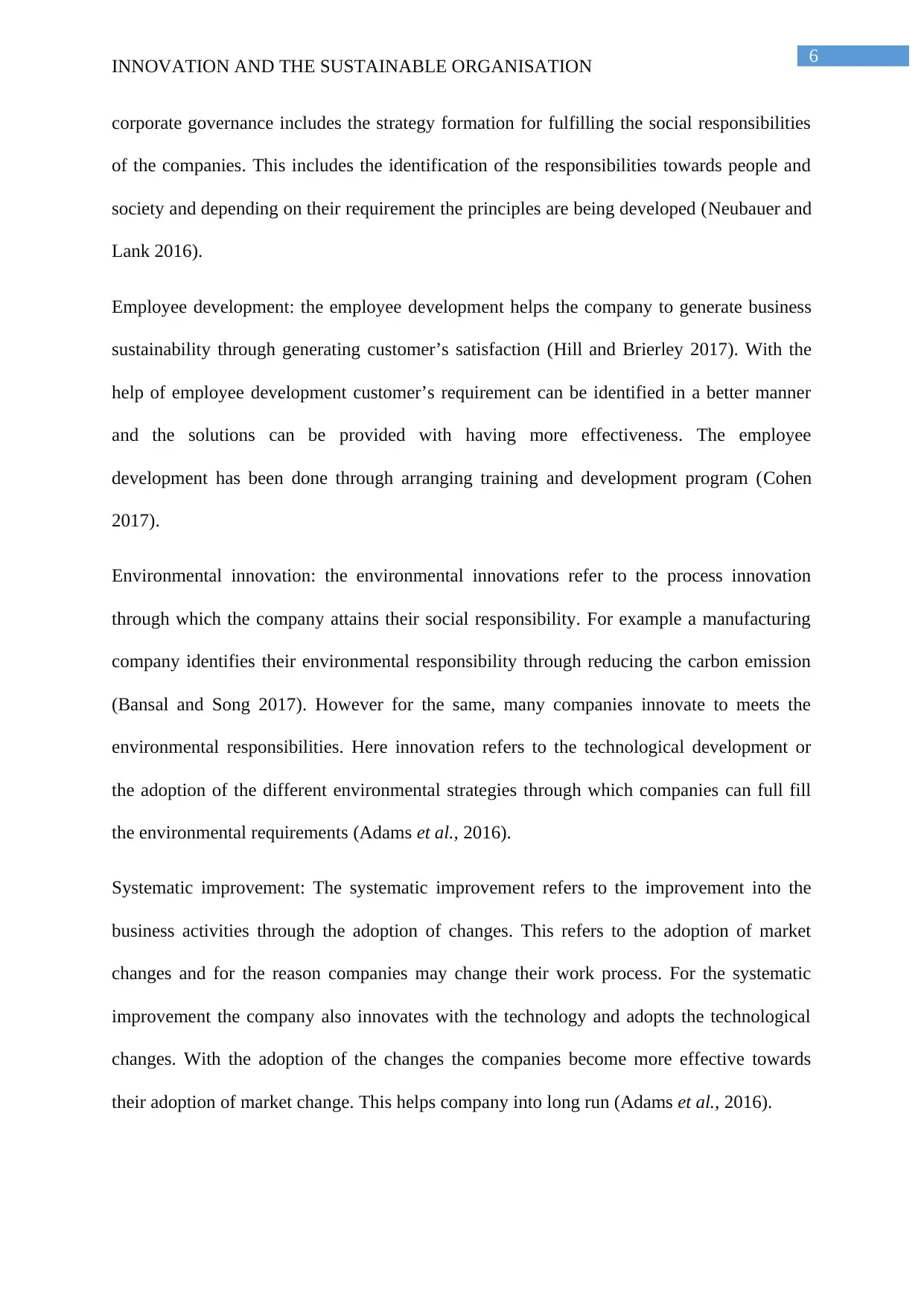
6
INNOVATION AND THE SUSTAINABLE ORGANISATION
corporate governance includes the strategy formation for fulfilling the social responsibilities
of the companies. This includes the identification of the responsibilities towards people and
society and depending on their requirement the principles are being developed (Neubauer and
Lank 2016).
Employee development: the employee development helps the company to generate business
sustainability through generating customer’s satisfaction (Hill and Brierley 2017). With the
help of employee development customer’s requirement can be identified in a better manner
and the solutions can be provided with having more effectiveness. The employee
development has been done through arranging training and development program (Cohen
2017).
Environmental innovation: the environmental innovations refer to the process innovation
through which the company attains their social responsibility. For example a manufacturing
company identifies their environmental responsibility through reducing the carbon emission
(Bansal and Song 2017). However for the same, many companies innovate to meets the
environmental responsibilities. Here innovation refers to the technological development or
the adoption of the different environmental strategies through which companies can full fill
the environmental requirements (Adams et al., 2016).
Systematic improvement: The systematic improvement refers to the improvement into the
business activities through the adoption of changes. This refers to the adoption of market
changes and for the reason companies may change their work process. For the systematic
improvement the company also innovates with the technology and adopts the technological
changes. With the adoption of the changes the companies become more effective towards
their adoption of market change. This helps company into long run (Adams et al., 2016).
INNOVATION AND THE SUSTAINABLE ORGANISATION
corporate governance includes the strategy formation for fulfilling the social responsibilities
of the companies. This includes the identification of the responsibilities towards people and
society and depending on their requirement the principles are being developed (Neubauer and
Lank 2016).
Employee development: the employee development helps the company to generate business
sustainability through generating customer’s satisfaction (Hill and Brierley 2017). With the
help of employee development customer’s requirement can be identified in a better manner
and the solutions can be provided with having more effectiveness. The employee
development has been done through arranging training and development program (Cohen
2017).
Environmental innovation: the environmental innovations refer to the process innovation
through which the company attains their social responsibility. For example a manufacturing
company identifies their environmental responsibility through reducing the carbon emission
(Bansal and Song 2017). However for the same, many companies innovate to meets the
environmental responsibilities. Here innovation refers to the technological development or
the adoption of the different environmental strategies through which companies can full fill
the environmental requirements (Adams et al., 2016).
Systematic improvement: The systematic improvement refers to the improvement into the
business activities through the adoption of changes. This refers to the adoption of market
changes and for the reason companies may change their work process. For the systematic
improvement the company also innovates with the technology and adopts the technological
changes. With the adoption of the changes the companies become more effective towards
their adoption of market change. This helps company into long run (Adams et al., 2016).
Paraphrase This Document
Need a fresh take? Get an instant paraphrase of this document with our AI Paraphraser
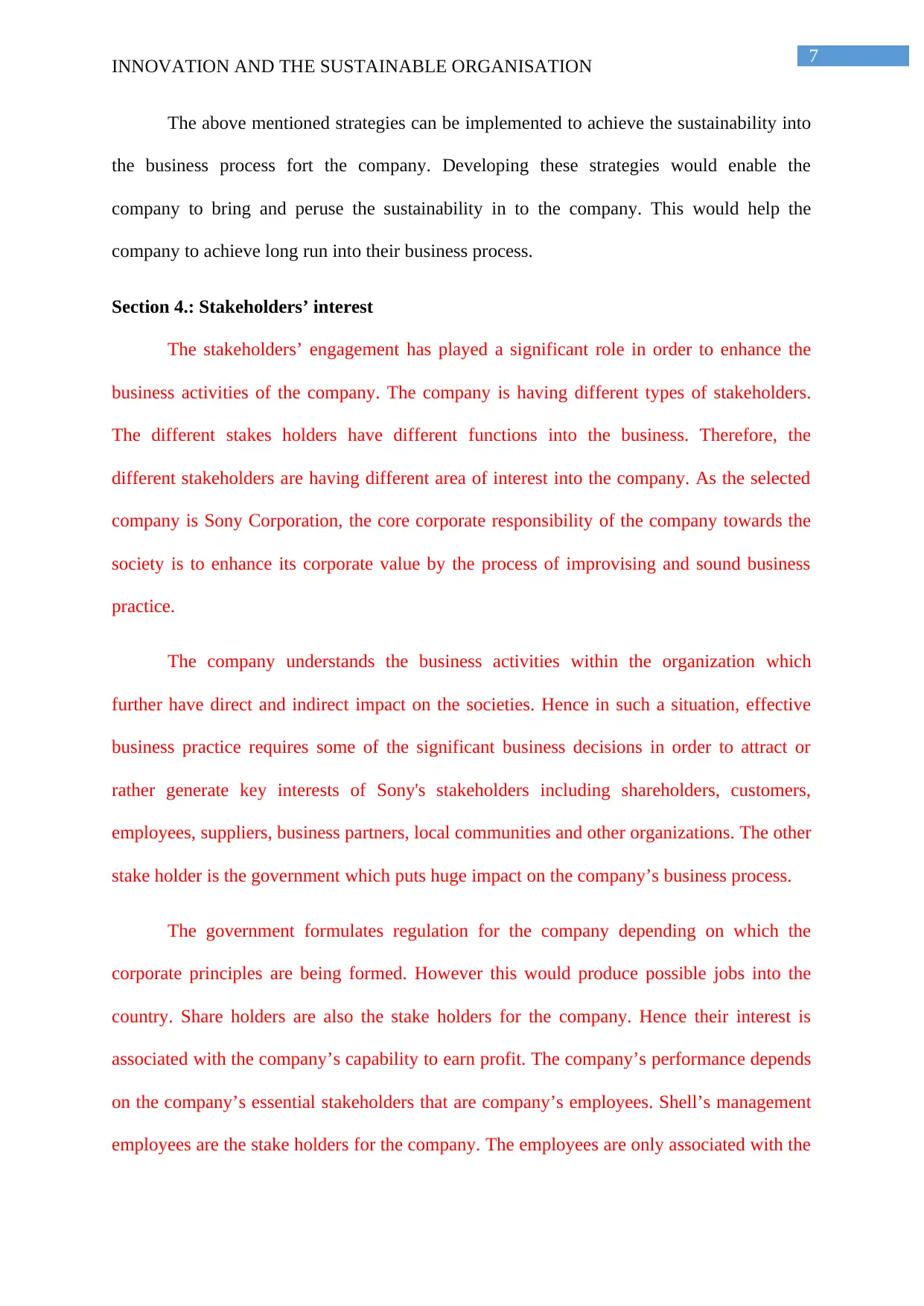
7
INNOVATION AND THE SUSTAINABLE ORGANISATION
The above mentioned strategies can be implemented to achieve the sustainability into
the business process fort the company. Developing these strategies would enable the
company to bring and peruse the sustainability in to the company. This would help the
company to achieve long run into their business process.
Section 4.: Stakeholders’ interest
The stakeholders’ engagement has played a significant role in order to enhance the
business activities of the company. The company is having different types of stakeholders.
The different stakes holders have different functions into the business. Therefore, the
different stakeholders are having different area of interest into the company. As the selected
company is Sony Corporation, the core corporate responsibility of the company towards the
society is to enhance its corporate value by the process of improvising and sound business
practice.
The company understands the business activities within the organization which
further have direct and indirect impact on the societies. Hence in such a situation, effective
business practice requires some of the significant business decisions in order to attract or
rather generate key interests of Sony's stakeholders including shareholders, customers,
employees, suppliers, business partners, local communities and other organizations. The other
stake holder is the government which puts huge impact on the company’s business process.
The government formulates regulation for the company depending on which the
corporate principles are being formed. However this would produce possible jobs into the
country. Share holders are also the stake holders for the company. Hence their interest is
associated with the company’s capability to earn profit. The company’s performance depends
on the company’s essential stakeholders that are company’s employees. Shell’s management
employees are the stake holders for the company. The employees are only associated with the
INNOVATION AND THE SUSTAINABLE ORGANISATION
The above mentioned strategies can be implemented to achieve the sustainability into
the business process fort the company. Developing these strategies would enable the
company to bring and peruse the sustainability in to the company. This would help the
company to achieve long run into their business process.
Section 4.: Stakeholders’ interest
The stakeholders’ engagement has played a significant role in order to enhance the
business activities of the company. The company is having different types of stakeholders.
The different stakes holders have different functions into the business. Therefore, the
different stakeholders are having different area of interest into the company. As the selected
company is Sony Corporation, the core corporate responsibility of the company towards the
society is to enhance its corporate value by the process of improvising and sound business
practice.
The company understands the business activities within the organization which
further have direct and indirect impact on the societies. Hence in such a situation, effective
business practice requires some of the significant business decisions in order to attract or
rather generate key interests of Sony's stakeholders including shareholders, customers,
employees, suppliers, business partners, local communities and other organizations. The other
stake holder is the government which puts huge impact on the company’s business process.
The government formulates regulation for the company depending on which the
corporate principles are being formed. However this would produce possible jobs into the
country. Share holders are also the stake holders for the company. Hence their interest is
associated with the company’s capability to earn profit. The company’s performance depends
on the company’s essential stakeholders that are company’s employees. Shell’s management
employees are the stake holders for the company. The employees are only associated with the
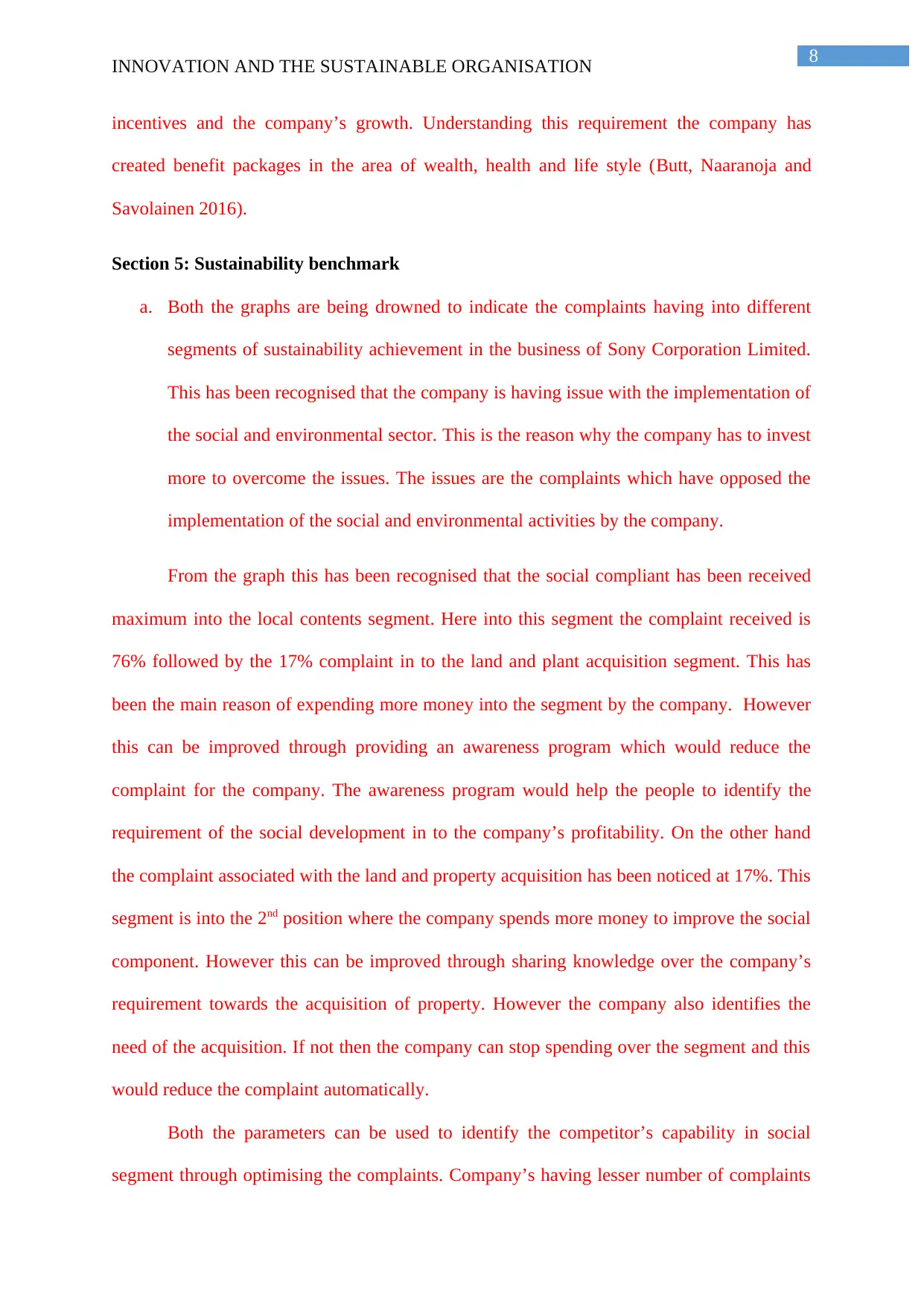
8
INNOVATION AND THE SUSTAINABLE ORGANISATION
incentives and the company’s growth. Understanding this requirement the company has
created benefit packages in the area of wealth, health and life style (Butt, Naaranoja and
Savolainen 2016).
Section 5: Sustainability benchmark
a. Both the graphs are being drowned to indicate the complaints having into different
segments of sustainability achievement in the business of Sony Corporation Limited.
This has been recognised that the company is having issue with the implementation of
the social and environmental sector. This is the reason why the company has to invest
more to overcome the issues. The issues are the complaints which have opposed the
implementation of the social and environmental activities by the company.
From the graph this has been recognised that the social compliant has been received
maximum into the local contents segment. Here into this segment the complaint received is
76% followed by the 17% complaint in to the land and plant acquisition segment. This has
been the main reason of expending more money into the segment by the company. However
this can be improved through providing an awareness program which would reduce the
complaint for the company. The awareness program would help the people to identify the
requirement of the social development in to the company’s profitability. On the other hand
the complaint associated with the land and property acquisition has been noticed at 17%. This
segment is into the 2nd position where the company spends more money to improve the social
component. However this can be improved through sharing knowledge over the company’s
requirement towards the acquisition of property. However the company also identifies the
need of the acquisition. If not then the company can stop spending over the segment and this
would reduce the complaint automatically.
Both the parameters can be used to identify the competitor’s capability in social
segment through optimising the complaints. Company’s having lesser number of complaints
INNOVATION AND THE SUSTAINABLE ORGANISATION
incentives and the company’s growth. Understanding this requirement the company has
created benefit packages in the area of wealth, health and life style (Butt, Naaranoja and
Savolainen 2016).
Section 5: Sustainability benchmark
a. Both the graphs are being drowned to indicate the complaints having into different
segments of sustainability achievement in the business of Sony Corporation Limited.
This has been recognised that the company is having issue with the implementation of
the social and environmental sector. This is the reason why the company has to invest
more to overcome the issues. The issues are the complaints which have opposed the
implementation of the social and environmental activities by the company.
From the graph this has been recognised that the social compliant has been received
maximum into the local contents segment. Here into this segment the complaint received is
76% followed by the 17% complaint in to the land and plant acquisition segment. This has
been the main reason of expending more money into the segment by the company. However
this can be improved through providing an awareness program which would reduce the
complaint for the company. The awareness program would help the people to identify the
requirement of the social development in to the company’s profitability. On the other hand
the complaint associated with the land and property acquisition has been noticed at 17%. This
segment is into the 2nd position where the company spends more money to improve the social
component. However this can be improved through sharing knowledge over the company’s
requirement towards the acquisition of property. However the company also identifies the
need of the acquisition. If not then the company can stop spending over the segment and this
would reduce the complaint automatically.
Both the parameters can be used to identify the competitor’s capability in social
segment through optimising the complaints. Company’s having lesser number of complaints
⊘ This is a preview!⊘
Do you want full access?
Subscribe today to unlock all pages.

Trusted by 1+ million students worldwide

9
INNOVATION AND THE SUSTAINABLE ORGANISATION
would be more successful towards achieving sustainability and profitability (Nagapurkar,
Paudel and Smith 2016).
On the other hand the environmental segment has also received complaints in the
implementation of the business process. The highest complaint has been received in the
flaring and the Nuisance with respective 20% and 48%. This can be improved through
employing better management process and the utilising technology into the production
process.
This has been recognised that competitors or other companies who are having lower
percentage in the environmental complaint segment are being recognised as the sustainable
company. This is because the company has followed a better management and production
process, due to which the lesser/no complaint has been received and social responsibilities are
being achieve.
b. Bothe the graphs are being recreated depending on the change of components. The
components are the complaint which are being reduced as a result of better internal,
internal and production management process. All the environmental factors are being
optimised and this is the reason why the new graphs have represented a lower
percentage of complaint.
c. Any manufacturing company would be suitable for the compression. This is because
the manufacturing companies are associated with the responsibility of reducing the
carbon emission as the company’s are associated with the manufacturing process.
Therefore the business process same and the complaint are same for any other
manufacturing company as their activities affect the environment which common for
all. Also the manufacturing companies face similar challenge towards managing
wastage and the water consumption. Therefore choosing any other manufacturing
INNOVATION AND THE SUSTAINABLE ORGANISATION
would be more successful towards achieving sustainability and profitability (Nagapurkar,
Paudel and Smith 2016).
On the other hand the environmental segment has also received complaints in the
implementation of the business process. The highest complaint has been received in the
flaring and the Nuisance with respective 20% and 48%. This can be improved through
employing better management process and the utilising technology into the production
process.
This has been recognised that competitors or other companies who are having lower
percentage in the environmental complaint segment are being recognised as the sustainable
company. This is because the company has followed a better management and production
process, due to which the lesser/no complaint has been received and social responsibilities are
being achieve.
b. Bothe the graphs are being recreated depending on the change of components. The
components are the complaint which are being reduced as a result of better internal,
internal and production management process. All the environmental factors are being
optimised and this is the reason why the new graphs have represented a lower
percentage of complaint.
c. Any manufacturing company would be suitable for the compression. This is because
the manufacturing companies are associated with the responsibility of reducing the
carbon emission as the company’s are associated with the manufacturing process.
Therefore the business process same and the complaint are same for any other
manufacturing company as their activities affect the environment which common for
all. Also the manufacturing companies face similar challenge towards managing
wastage and the water consumption. Therefore choosing any other manufacturing
Paraphrase This Document
Need a fresh take? Get an instant paraphrase of this document with our AI Paraphraser

10
INNOVATION AND THE SUSTAINABLE ORGANISATION
company for the comparison would provide a better idea over the sustainability
strategy, adopted by the others. This would help in evaluating the sustainability
strategy for the company.
Conclusion
The study has provided idea on the sustainability strategy adopted by Sony
Corporation. However the study has also provided an idea over the company’s performance
and the profitability through utilising sustainability strategy. The study has identified the
strategy adopted by the company through which the sustainability has been achieved. Using
these strategies the betterment into the performance has been recognised. However few loop
wholes have also been identified through analysing the environmental and social complaints.
This has been represented through the graph and compared with the competitors. For the
betterment of the sustainability strategy a change has been brought into the sustainability
strategy through which the success has been achieved. The changes over has been made into
the component where the drivers are being kept low through providing a better management
process and optimising the complaints.
INNOVATION AND THE SUSTAINABLE ORGANISATION
company for the comparison would provide a better idea over the sustainability
strategy, adopted by the others. This would help in evaluating the sustainability
strategy for the company.
Conclusion
The study has provided idea on the sustainability strategy adopted by Sony
Corporation. However the study has also provided an idea over the company’s performance
and the profitability through utilising sustainability strategy. The study has identified the
strategy adopted by the company through which the sustainability has been achieved. Using
these strategies the betterment into the performance has been recognised. However few loop
wholes have also been identified through analysing the environmental and social complaints.
This has been represented through the graph and compared with the competitors. For the
betterment of the sustainability strategy a change has been brought into the sustainability
strategy through which the success has been achieved. The changes over has been made into
the component where the drivers are being kept low through providing a better management
process and optimising the complaints.
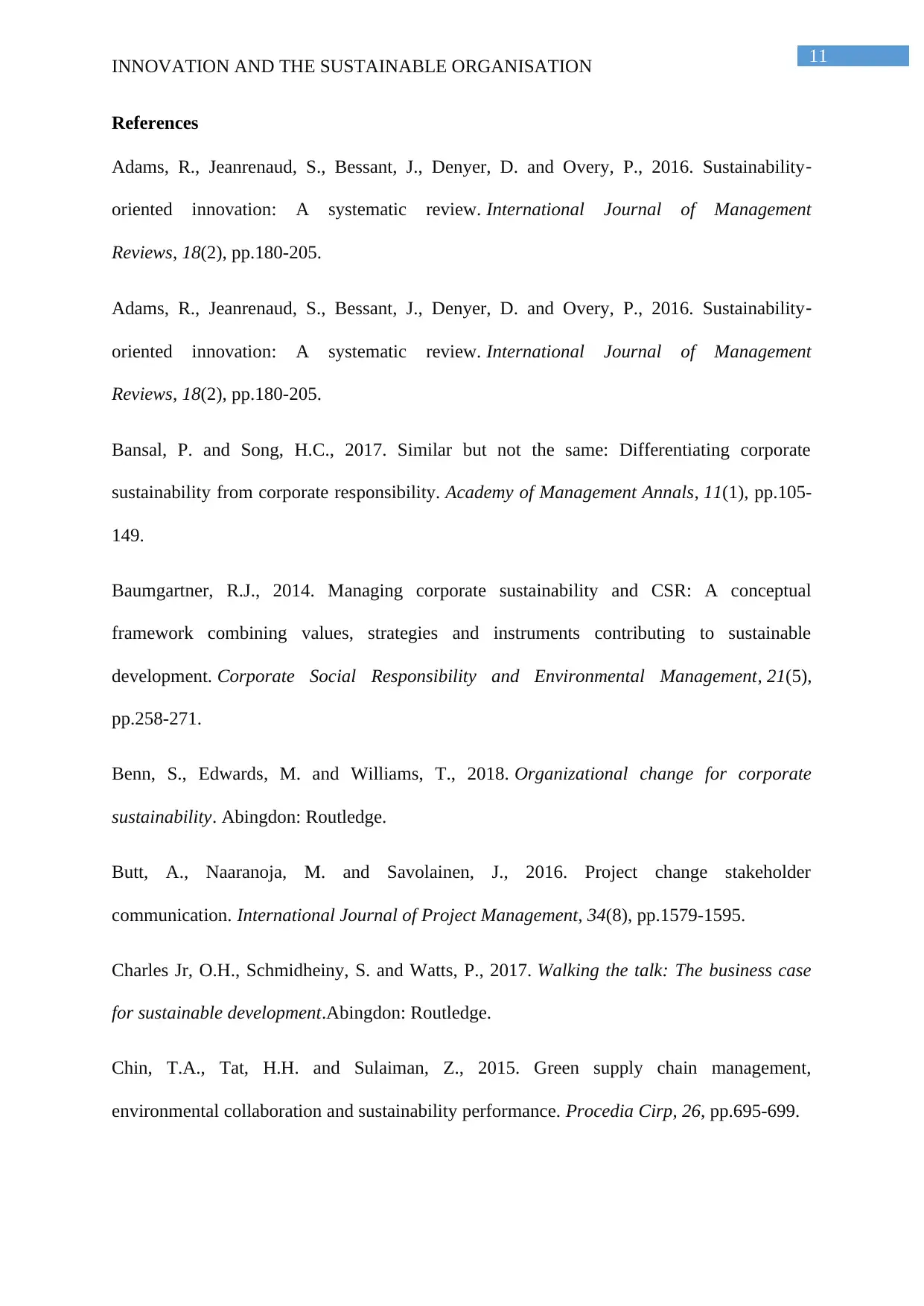
11
INNOVATION AND THE SUSTAINABLE ORGANISATION
References
Adams, R., Jeanrenaud, S., Bessant, J., Denyer, D. and Overy, P., 2016. Sustainability‐
oriented innovation: A systematic review. International Journal of Management
Reviews, 18(2), pp.180-205.
Adams, R., Jeanrenaud, S., Bessant, J., Denyer, D. and Overy, P., 2016. Sustainability‐
oriented innovation: A systematic review. International Journal of Management
Reviews, 18(2), pp.180-205.
Bansal, P. and Song, H.C., 2017. Similar but not the same: Differentiating corporate
sustainability from corporate responsibility. Academy of Management Annals, 11(1), pp.105-
149.
Baumgartner, R.J., 2014. Managing corporate sustainability and CSR: A conceptual
framework combining values, strategies and instruments contributing to sustainable
development. Corporate Social Responsibility and Environmental Management, 21(5),
pp.258-271.
Benn, S., Edwards, M. and Williams, T., 2018. Organizational change for corporate
sustainability. Abingdon: Routledge.
Butt, A., Naaranoja, M. and Savolainen, J., 2016. Project change stakeholder
communication. International Journal of Project Management, 34(8), pp.1579-1595.
Charles Jr, O.H., Schmidheiny, S. and Watts, P., 2017. Walking the talk: The business case
for sustainable development.Abingdon: Routledge.
Chin, T.A., Tat, H.H. and Sulaiman, Z., 2015. Green supply chain management,
environmental collaboration and sustainability performance. Procedia Cirp, 26, pp.695-699.
INNOVATION AND THE SUSTAINABLE ORGANISATION
References
Adams, R., Jeanrenaud, S., Bessant, J., Denyer, D. and Overy, P., 2016. Sustainability‐
oriented innovation: A systematic review. International Journal of Management
Reviews, 18(2), pp.180-205.
Adams, R., Jeanrenaud, S., Bessant, J., Denyer, D. and Overy, P., 2016. Sustainability‐
oriented innovation: A systematic review. International Journal of Management
Reviews, 18(2), pp.180-205.
Bansal, P. and Song, H.C., 2017. Similar but not the same: Differentiating corporate
sustainability from corporate responsibility. Academy of Management Annals, 11(1), pp.105-
149.
Baumgartner, R.J., 2014. Managing corporate sustainability and CSR: A conceptual
framework combining values, strategies and instruments contributing to sustainable
development. Corporate Social Responsibility and Environmental Management, 21(5),
pp.258-271.
Benn, S., Edwards, M. and Williams, T., 2018. Organizational change for corporate
sustainability. Abingdon: Routledge.
Butt, A., Naaranoja, M. and Savolainen, J., 2016. Project change stakeholder
communication. International Journal of Project Management, 34(8), pp.1579-1595.
Charles Jr, O.H., Schmidheiny, S. and Watts, P., 2017. Walking the talk: The business case
for sustainable development.Abingdon: Routledge.
Chin, T.A., Tat, H.H. and Sulaiman, Z., 2015. Green supply chain management,
environmental collaboration and sustainability performance. Procedia Cirp, 26, pp.695-699.
⊘ This is a preview!⊘
Do you want full access?
Subscribe today to unlock all pages.

Trusted by 1+ million students worldwide
1 out of 14
Related Documents
Your All-in-One AI-Powered Toolkit for Academic Success.
+13062052269
info@desklib.com
Available 24*7 on WhatsApp / Email
![[object Object]](/_next/static/media/star-bottom.7253800d.svg)
Unlock your academic potential
Copyright © 2020–2025 A2Z Services. All Rights Reserved. Developed and managed by ZUCOL.




